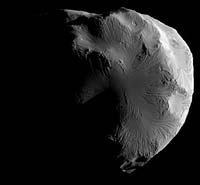|
COMETS EARTH JUPITER KUIPER BELT MARS MERCURY METEORITES NEPTUNE OORT CLOUD PLUTO SATURN SOLAR SYSTEM SPACE SUN URANUS VENUS ORDER PRINTS
PHOTO CATEGORIES SCIENCEVIEWS AMERICAN INDIAN AMPHIBIANS BIRDS BUGS FINE ART FOSSILS THE ISLANDS HISTORICAL PHOTOS MAMMALS OTHER PARKS PLANTS RELIGIOUS REPTILES SCIENCEVIEWS PRINTS
|
Related Documents
Download Options
The Cassini spacecraft snapped this image of Saturn's moon Helene while completing the mission's second-closest encounter of the moon on June 18, 2011. Although Cassini's closest flyby of Helene was in March 2010 (see PIA12723 and PIA12653), this June 2011 flyby yielded some of the highest resolution images of the moon. Lit terrain seen here is on the leading hemisphere of Helene (33 kilometers, or 21 miles across). North on Helene is up. The image was taken in visible light with the Cassini spacecraft narrow-angle camera. The view was obtained at a distance of approximately 7,000 kilometers (4,000 miles) from Helene and at a Sun-Helene-spacecraft, or phase, angle of 104 degrees. Image scale is 42 meters (137 feet) per pixel. The Cassini-Huygens mission is a cooperative project of NASA, the European Space Agency and the Italian Space Agency. The Jet Propulsion Laboratory, a division of the California Institute of Technology in Pasadena, manages the mission for NASA's Science Mission Directorate, Washington, D.C. The Cassini orbiter and its two onboard cameras were designed, developed and assembled at JPL. The imaging operations center is based at the Space Science Institute in Boulder, Colo. |
